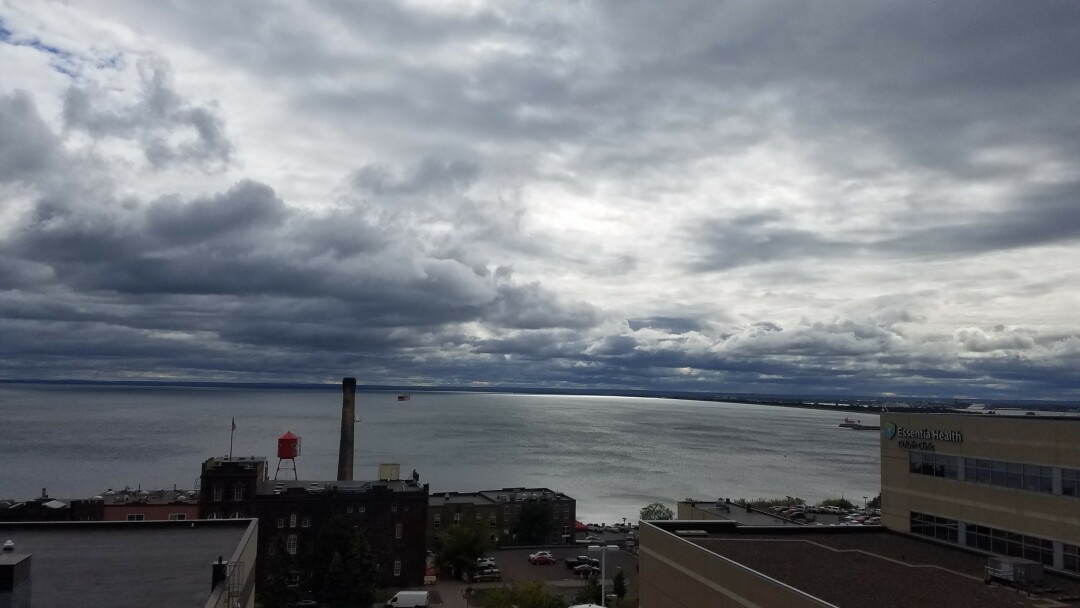Duluth, welcome to the new earth

Blustery day over Lake Superior Sept. 28. Photo by Richard Thomas.
On Sept. 16, a front-page article in the New York Times, “Emergency From Climate Change On Two Coasts,” reported that Hurricane Sally had slowed down over the Gulf of Mexico. This event represented what is called a “climate change reality,” in which many hurricanes are becoming wetter, slower and more dangerous. Also, the wildfires along the West Coast had incinerated millions of acres and sent foul air into the atmosphere as far away as Washington, D.C. The “scorching summer” led to dry conditions that turned this year’s wildfires into the worst ever recorded.
Three days earlier, the Chicago Sun-Times editorial board presented a column in which they wrote “We need to step up now and do everything we can to break these cataclysmic feedback loops.” Highlighting the California wildfires and Chicago’s derecho, the editorial board stressed how these climate changes are coming on faster and stronger than many scientists had expected. Besides the hotter weather in the West that was drying out the soil, the Midwest was experiencing a derecho that contributed to Chicago losing thousands of trees. The loss of trees would create more heat islands, more flooding and poorer air quality.
In August, the National Oceanic and Atmospheric Administration reported that the U.S. was hit by four different “billion dollar disasters,” the wildfires, the derecho and two hurricanes. The editorial board concluded that “record breaking wildfires and storms are just part of the beginning of the destruction to come.”
Back in 2010, in his book “eaarth: Making A Life On A Tough New Planet,” Bill McKibben stated, “We can’t live on the new earth as if it were the old earth; we’ve foreclosed that option.” Citing that one hundred eleven hurricanes formed in the tropical Atlantic between 1995 and 2008 (a rise of 75 percent over the previous 13 years), the temperatures in the Antarctic Peninsula were rising faster than anywhere else in earth, the sea was already 30 percent more acidic than it would have been because of emissions, and that by the end of 2008 hydrologists in the U.S. were predicting that drought across the American Southwest had become a permanent condition, McKibben wrote, “We’re not, in other words, going to get back the planet we used to have, the one on which our civilization depended.”
It’s quite clear that the earth which I have grown up with over the past 65 years has changed drastically. In the appendix to her book “The Story Of More,” Hope Jahren states that globally since 1969, one trillion tons of carbon dioxide have been released into the atmosphere from the burning of fossil fuels, the average global surface temperatures has increased by one degree Fahrenheit, the global sea level has increased by four inches, and that more than half of all amphibian, bird and butterfly species has declined in population.
Between September and December of 2018, there were six major stories about climate change; including the Trump administration’s plans to withdraw from the Paris Agreement and reverse many current federal environmental policies. On Sept. 28, the National Highway Traffic Safety Administration issued a statement which reported that by 2100, if current standards remain the same, the planet will warm by seven degrees Fahrenheit (four degrees Celsius). Six weeks later, on Nov. 23, the U.S. Global Change Research Program published the Fourth National Climate Assessment, which stated, “Earth’s climate is now changing faster than at any point in the history of modern civilization, primarily as a result of human activities.” It was reported that the impacts of global climate change were already being felt in the U.S. and were projected to intensify in the future. Also, it further stated that “climate change is transforming where and how we live, and presents growing challenges to human health and quality of life, the economy, and the natural systems that support us.” And then on Nov. 29, the World Meteorological Organization released a report stating that 2017 atmospheric carbon dioxide levels reached 405 parts per million, a level not seen in 3 million years.
Closer to home, in the spring of 2018, a report entitled “Vulnerable Populations and Climate Adaptation Framework” was presented to Duluth’s city government. Funded by an Environmental Assistance Grant by the Minnesota Pollution Control Agency, the report’s opening statement was “Climate change is a global phenomenon that creates local impacts.” This report stated that from 1950 to 2015 the city of Duluth had experienced a 1.8 degree increase in the annual average temperature, a decrease of eight days below 32 degrees, and an increase of extreme weather events of 58 percent. It also predicted that by 2100, Duluth could expect an increase of 4 to 11 degrees in the annual average temperature, an increase to 23 days above 95 degrees and 50 fewer days below freezing. By the middle of this century, somewhere between 2040 and 2070, summertime conditions for Duluth would be similar to the current conditions felt over 250 miles to the south.
According to the report, there are populations of “particular vulnerability” which includes children under five, older adults, individuals with disabilities, individuals in economic stress, and individuals employed in climate vulnerable jobs.
And then in 2019, two important climate news stories came out about the Great Lakes. On March 21, the Duluth News Tribune published an article entitled “Great Lakes Already Hit By Change Change.” It reported that the Great Lakes region is already warming and changing faster than much of North America and will continue to do so as global warming increases. Compiled by eighteen scientists from the U.S. and Canada, they gathered data from previous studies that looked at ecosystems, climate, agriculture, economics and human health. It was called the most comprehensive assessment of climate impact on the region ever compiled.
According to the report, the Great Lakes will see more algae blooms, more harmful bacteria in the water, more intense storms and warmer temperatures. The states in the Great Lakes region should prepare for the likelihood of more extreme weather events; including more flooding early in the year, more heat waves and drought in hotter months, an overall decrease in snowfall and snow cover, and more lake-effect snow storms of “significant magnitude.”
Then on Aug. 12, the Star Tribune published an article, “Great Lakes’ latest pollution threat is microplastics.” UMD’s Large Lake Observatory was launching a new study of inland lakes and fish as a follow up to last year’s report in the Environmental Science and Technology Journal where they found 20,000 particles of microplastics per square kilometer in the Western Lake Superior Basin.
It was in April of last year when Duluth Mayor Emily Larson, in her State of the City address, said, “Climate change is pounding our city.” While the mayor was referring to Lake Superior’s impact upon Duluth’s shoreline, her words could also serve as a warning call to all of us with regards to the growing challenges and complexity of climate change and its numerous impacts upon our city.
I’m wondering if our leaders in city and county government as well as the business community know that we’re living on a new earth. Wondering if the leaders with the various community and social service organizations understand the impact of climate change upon the vulnerable populations which they serve every day. Wondering if my friends and neighbors realize how climate change will make them more vulnerable in the future.
As reported in Naomi Klein’s book “On Fire,” Robert Watson, serving as chair of the United Nations’ Intergovernmental Science-Policy Platform on Biodiversity and Ecosystem Services 2019 report, said, “The health of ecosystems on which we and all other species depend is deteriorating more rapidly than ever. We are eroding the very foundations of economies, livelihoods, food security, health and quality of life worldwide.” Klein herself wrote, “The first stage is to name the emergency, because only once we are on emergency footing will we find the capacity to do what is required.”
So, with this new earth, which is experiencing a plethora of dramatic and devastating climate change events around the world, has Duluth acknowledged and named the emergency? Who and what do we have in our government and within the greater community that can help guide Duluth to become a more resilient, sustainable and environmentally just city on this new earth?
Tone Lanzillo, a member of the Loaves and Fishes community in Duluth, is coordinating the Duluth/365 project - asking people to engage in various climate change actions within the next 365 days. facebook.com/climatechangeduluth
